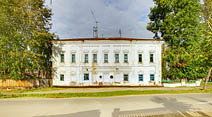























































Вы используете крайне устаревший браузер, который не поддерживает технологические решения, используемые на данном сайте. Кроме того, работа в сети Интернет с использованием устаревшего браузера крайне опасна для вашего компьютера. Настоятельно рекомендуем обновить ваш браузер, установив один из перечисленных ниже с сайта его производителя:
---------------------------------------------------------------------------
You are using a very old browser that does not support the technological solutions used on this site. In addition, working in the Internet using an outdated browser is very dangerous for your computer. We strongly recommend you to upgrade your browser to one of the following from the site of its manufacturer:
 Address: ул. Ленина, 83
Address: ул. Ленина, 83
The two-storeyed stone building covered with iron hipped roof is located on the site of the former trading quarter in the historical part of Yeniseisk. To Lenin Street it is turned by the northern seven-axis facade which is a little back out of the frontage line of building, the east nine-axis is turned to Lytkin Street.
The middle part of the western facade is adjoined by a stone porch with a stairs to the upper floor. The complex planning structure is formed by longitudinal and transverse walls with allocation of a middle outer entrance hall. Rooms of the first floor are blocked by the close and barrel vault. In stylistic forms the building belongs to Yeniseisk monuments of architecture of the last quarter of the 18th century (the building of Offices and the rectory building of the Spassky monastery) among which it, undoubtedly, is the earliest. The house was probably built before the fire of 1778 and the beginning of the regular re-planning of a part of the town behind the river Melnichnaya as a result of which it was on the line of Bolshaya St. opposite the Monastery of the Nativity of Christ. For the first time it is shown on the tpwn map of 1797.
The society of gold industry entrepreneurs gathered in this house in 1858, then the women's school opened in 1860 at the initiative of A. S. Balandin was located.
In 1870 the house was taken over by the Yeniseisk merchant V. Gryaznov. In 1882 a second town parochial school was opened in it, and at the end of the 19th century the printing house is placed.